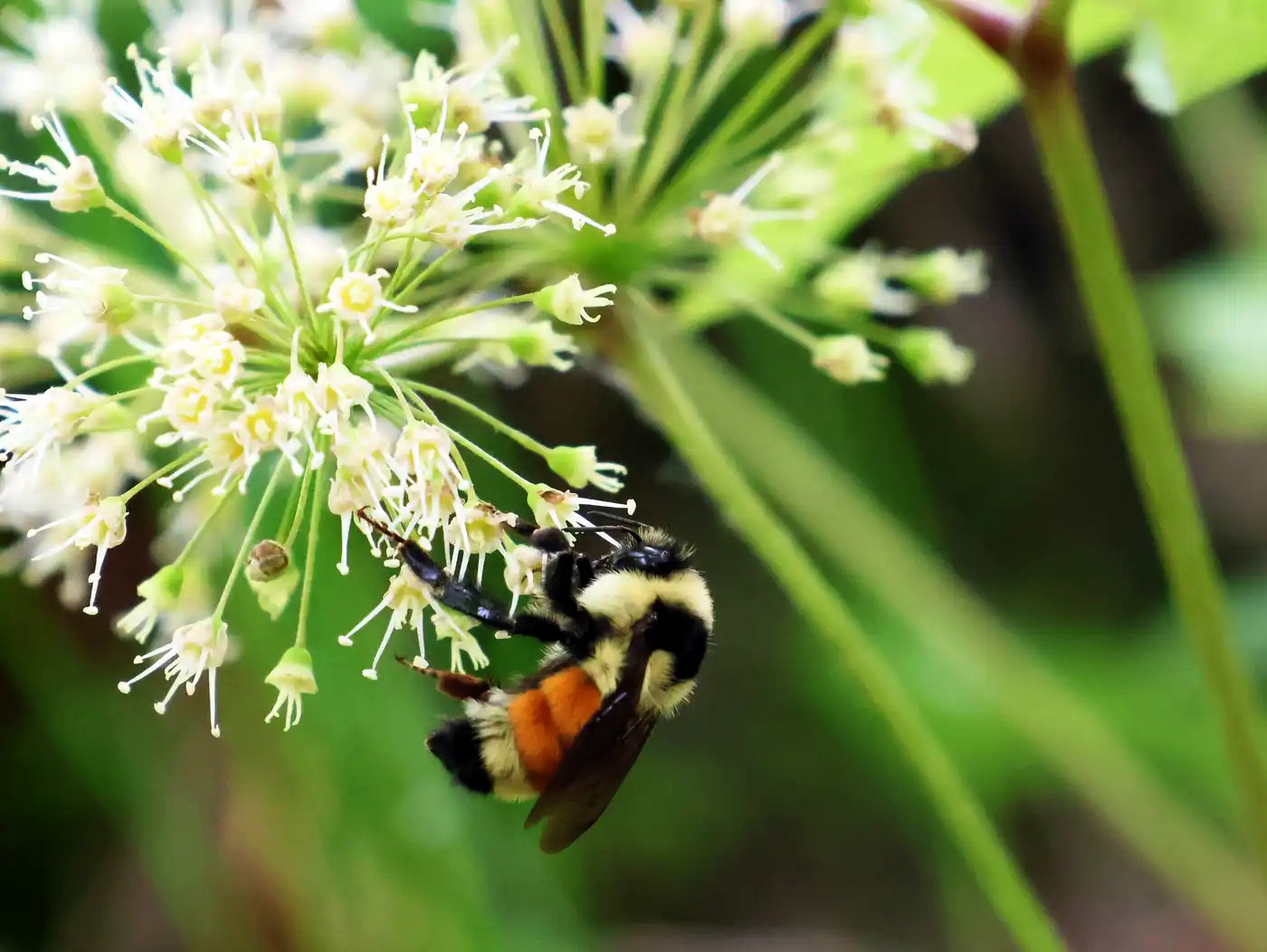
Volunteers are needed for statewide Minnesota bumble bee survey
The endangered rusty-patched bumble bee has achieved fame as the Minnesota state bee. It’s just one of about two dozen bumble bee species in Minnesota and scientists suspect others are at risk and need help, but they lack the data to understand statewide bumble bee populations.
The Minnesota Bumble Bee Atlas is a way to use citizen science to gather the data.
Volunteer Karen Kaehler is an enthusiastic bumble bee observer and atlas contributor. She calls out “Where are you ladies?” as she peers into a patch of wild sarsaparilla outside her home near Longville.
Minnesota Bumble Bee Atlas volunteer Karen Kaehler looks for bees among native plants along the shoreline of her home near Longville, Minn. (Dan Gunderson / MPR News)
A moment later, a queen bumble bee appears from under a leaf.
“This is the most common species in northern Minnesota,” said Kaehler. “Bombus ternarius, or sometimes it’s called orange-belted bumble bee or tri-colored bumble bee.”
Kaehler has been counting and identifying bees for seven years for the Bumble Bee Atlas. She knows this species well.
She’s even picked up the ability to quickly identify many bumble bee species sitting on a flower.
“It’s kind of like (when) you buy a new car and then you constantly see that new car on the road,” she said. “My eye sees bumble bees now.”
The Minnesota Bumble Bee Atlas started in the Twin Cities but has since expanded statewide.
It’s now affiliated with the Xerces Society national data collection effort. There are about 50 bumble bee species across North America.
Volunteers are trained to carefully catch, identify, document and release bumble bees under an established scientific protocol. The project goal is to gather data about various species statewide.
“When we first started doing bumble bee surveys in Minnesota back in 2007, we had 20 bumble bee species that we knew were here in Minnesota and now we’re up to 24,” said University of Minnesota bumble bee expert Elaine Evans.
Volunteers have found species that haven’t been documented in the state for decades, and species that have never before been found in the state.
Researchers knew the tri-colored bumble bee in Kaehler’s yard was common in Minnesota. Thanks to the Bee Atlas, they now know it’s most common in the northern half of the state.
Three years ago, volunteer Tony Ernst was doing a survey in Cook County when he found a bee that wasn’t on the list of species he was seeking.
“It turned out to be one that wasn’t known to be in Minnesota,” said Ernst, who learned the species he found was last seen decades ago. “It’s just that in these remote parts of the state, who’s looking?”
Ernst looks forward to the bumble bee survey each summer because being outdoors is his “happy place” and he always learns something about bee behavior or habitat.
The Minnesota Bumble Bee Atlas project is trying to recruit more volunteers. There are 87 grids to be cataloged annually across the state while the project averages 30 to 40 volunteers per year.
“Some of those volunteers will go to multiple grids,” said Evans. “A bit more than half of our grids have kind of our minimum survey effort. We want to have at least two surveys done in each of the grids.”
Many grids in the western and northern part of the state are not being surveyed because there are no volunteers.
A statewide perspective on bumble bee populations is important because understanding where bumble bee species live helps researchers find connections between bees and the habitat they need to be successful.
“We know about some species of bumble bees; we don’t have information about a lot of species of bumble bees,” said Evans. By looking at data collected in years past, she said, “we’re able to collect that information on a broad scale and make those connections.”
Kaehler looks forward to the time spent catching bees each summer. She is partly motivated by knowing that she is contributing to scientific research, and learning about bumble bees has sparked a passion for wild bees.
“You really become very fascinated by bees,” she said.
“They’re not icky. They’re cute, they’re sweet. They’re soft and fuzzy and they’re easy to get to know and love.”
To learn more
For more information about the project, go to mnbumblebeeatlas.umn.edu.
Related Articles
University of Minnesota approves tuition increases
‘You saved my life,’ German 3M manager tells St. Paul firefighters who treated him last visit
Former Current DJ Mary Lucia has returned to radio
Pro-Palestinian protesters at UMN and other campuses demand endowment transparency. But it’s proving not to be simple.
Thomas Friedman: Why the campus protests are so troubling


